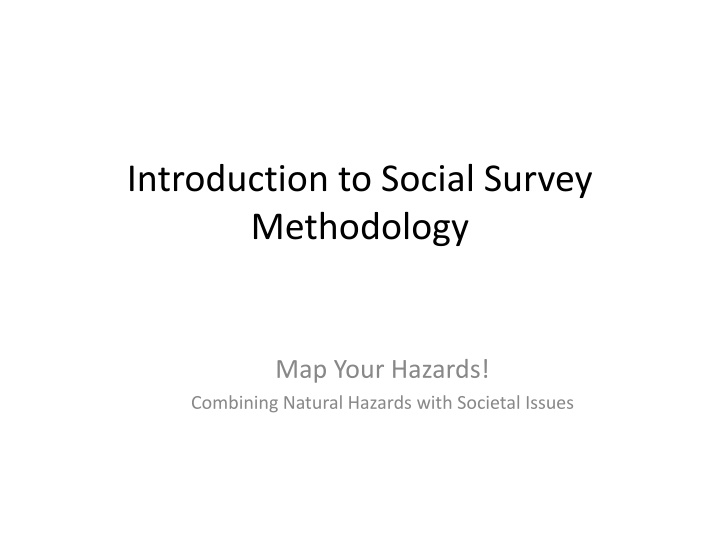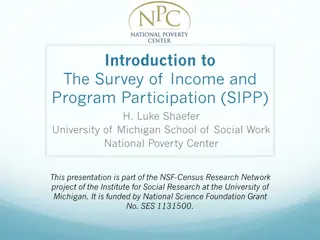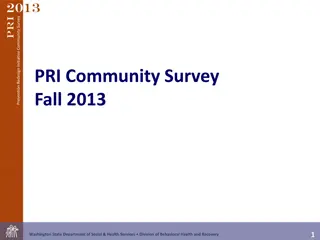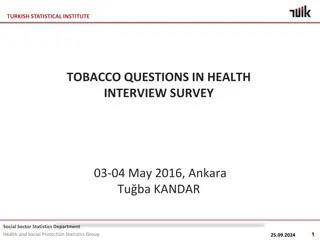
Social Survey Methodology: Practical Guidelines for Effective Research
Explore the essentials of social survey methodology, including designing appropriate questions, ensuring ethics and reliability, defining populations and samples, structuring research designs, and utilizing various question formats for data collection.
Download Presentation

Please find below an Image/Link to download the presentation.
The content on the website is provided AS IS for your information and personal use only. It may not be sold, licensed, or shared on other websites without obtaining consent from the author. If you encounter any issues during the download, it is possible that the publisher has removed the file from their server.
You are allowed to download the files provided on this website for personal or commercial use, subject to the condition that they are used lawfully. All files are the property of their respective owners.
The content on the website is provided AS IS for your information and personal use only. It may not be sold, licensed, or shared on other websites without obtaining consent from the author.
E N D
Presentation Transcript
Introduction to Social Survey Methodology Map Your Hazards! Combining Natural Hazards with Societal Issues
Rules of Practice for Research Appropriate Questions Ethics, Credibility, Reliability, Validity Technique and Design Proper Sampling Pilot Testing Analysis Specific Purpose for Study What are you trying to describe, explain or explore? 2
Appropriate Questions & Means Collecting information about individuals: Attitudes, ideas, beliefs, opinions, feelings, background, behavior, orientations or plans for the future Questionnaires (Surveys) vs. Interviews Quantitative vs. Qualitative Systematic and structured questions (closed) Open-ended, more descriptive 3
Ethics, Credibility, Validity, Reliability Ethics Protect privacy of individuals, confidentiality, willingness to participate Credibility Conveys purpose, how worthwhile it is, and who is responsible Validity Data test hypothesis, measure what it claims to measure Reliability Consistent measure and representative 4
Population/Sample Who is your target population? Identify representative sample and make generalizations Sample size: The larger the better. Good size is between 100 250. Need at least 30 to be reliable (including interviews) Random: known chance of inclusion Non-random measures: Snowball Quota (street survey) Accidental (student projects) 5
Research Design Relevance What are you trying to discover (do questions get at this)? Comprehensiveness What are the independent & dependent variables? How do you classify? Is it clear? Aptness Data that are readily coded and analyzed Feasibility Not too long or complicated Unambiguous Are the questions and categories exhaustive and mutually exclusive? 6
Question Formats Scales of measure (nominal, ordinal and interval) Likert measures strength of motivations, attitudes, opinions (e.g. Strongly Agree Strongly Disagree) Checklists, rankings, ratings and degrees of importance (e.g. scale of 1 5) Recurrent behavior (e.g. How often do you . . .) Coded categories (e.g. yes/no, male/female) Including DK or Other as optional categories Open-ended (categories must be mutually exclusive) 7
Pilot Study Must conduct a trial run with sample survey to verify the design and fine-tune the questions Looking for bias, clarity and spuriousness Everyone (even seasoned social scientists) goes through this process Otherwise you end up with a lousy survey that will not get a good response 8
Data Analysis What will the questions produce? Discursive (summarize in words) Graphs (bar charts of nominal and ordinal variables) Histograms (continuous and interval data) Crosstabs (chi-square) Multivariate analysis (optional) 9






















